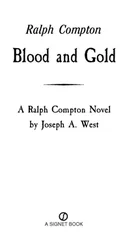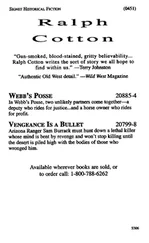Ralph Compton - Bounty Hunter
Здесь есть возможность читать онлайн «Ralph Compton - Bounty Hunter» весь текст электронной книги совершенно бесплатно (целиком полную версию без сокращений). В некоторых случаях можно слушать аудио, скачать через торрент в формате fb2 и присутствует краткое содержание. Год выпуска: 2009, ISBN: 2009, Издательство: Penguin Group US, Жанр: Старинная литература, на английском языке. Описание произведения, (предисловие) а так же отзывы посетителей доступны на портале библиотеки ЛибКат.
- Название:Bounty Hunter
- Автор:
- Издательство:Penguin Group US
- Жанр:
- Год:2009
- ISBN:9781101140680
- Рейтинг книги:3 / 5. Голосов: 1
-
Избранное:Добавить в избранное
- Отзывы:
-
Ваша оценка:
- 60
- 1
- 2
- 3
- 4
- 5
Bounty Hunter: краткое содержание, описание и аннотация
Предлагаем к чтению аннотацию, описание, краткое содержание или предисловие (зависит от того, что написал сам автор книги «Bounty Hunter»). Если вы не нашли необходимую информацию о книге — напишите в комментариях, мы постараемся отыскать её.
Bounty Hunter — читать онлайн бесплатно полную книгу (весь текст) целиком
Ниже представлен текст книги, разбитый по страницам. Система сохранения места последней прочитанной страницы, позволяет с удобством читать онлайн бесплатно книгу «Bounty Hunter», без необходимости каждый раз заново искать на чём Вы остановились. Поставьте закладку, и сможете в любой момент перейти на страницу, на которой закончили чтение.
Интервал:
Закладка:
He knew he’d never wear it.
The time of the bounty hunter was almost done and would soon go the way of the buffalo and the Indian. He realized that. The growth of cities, better law enforcement, the telegraph and the newfangled telephone were shrinking distances even across the vast western lands and, like his own, the days of the roaming outlaw were surely numbered.
But the West was a beautiful, mysterious woman singing her siren song to Tone. She was calling him home to the aloof mountains, the quiet forests and the limitless plains, seductively reminding him what it was like to watch the smoke of his fire rise like incense to pay homage to the stars. He recalled the play of sunlight on a trout stream, the rustle of aspens and the sigh of tall pines in the wind.
He could not turn his back on her. Not now, not ever. To do so would be to spit on his life.
The path he had chosen was one of flame-streaked violence and sudden death. He knew that one day he would end up with his face in the sawdust of a sod saloon in a one-loop town somebody had named Who-Gives-a-Damn. But that was his choice and he would accept its consequences.
Tone rose and dressed in his peacoat and watch cap. Langford had cleaned and loaded his guns and he dropped them into his pockets. He stepped quietly to the kitchen, hearing the cop’s soft snoring from the other bedroom.
Tone found pen and paper and wrote: Thomas, if you’re ever in Reno . . .
He had no need to write more. Langford would know.
Tone walked to the front of the house, stepped outside and quietly closed the door behind him.
Acknowledgments
The author would like to thank the City of San Francisco and its police department for their valuable insights into the life and times of Sergeant Thomas Langford and his role in policing the crime- and violence-ridden Barbary Coast in the 1880s.
I’m indebted to Thomas Asbury for his wonderful book The Barbary Coast , published by Alfred A. Knopf in 1937. Also to Colonel Albert S. Evans’ Sketch of Life in the Golden State (1871) and to Frank Soule and Dr. John H. Gihon for The Annals of San Francisco (1855).
According to a 2005 article in Britain’s Manchester Guardian newspaper, Jack the Ripper may have been a merchant seaman who arrived in England aboard the cargo vessel Sylph in July 1888, just before the murder of his first victim, Mary Ann Nichols. The Sylph returned to the Caribbean on September 22, two weeks after the gruesome killing of prostitute Mary Kelly. In January 1889, six prostitutes were murdered in Managua, the capital of Nicaragua. Police later said the victims “were mutilated beyond all recognition, their faces horribly slashed.”
Jack may have returned to England and murdered Whitechapel prostitute Alice McKenzie on July 17, 1889. Although never officially listed as a Ripper victim, the woman was strangled, her throat slashed and her body mutilated.
Jack may have then left England and murdered and mutilated a woman in Hamburg, Germany, on October 18, 1889, before vanishing into the fog for the last time.
Was Jolly Jack a seaman or a paying passenger, say a rich lawyer? In the Ripper saga, all things are possible.
SIGNET
Published by New American Library, a division of
Penguin Group (USA) Inc., 375 Hudson Street,
New York, New York 10014, USA
Penguin Group (Canada), 90 Eglinton Avenue East, Suite 700, Toronto,
Ontario M4P 2Y3, Canada (a division of Pearson Penguin Canada Inc.)
Penguin Books Ltd., 80 Strand, London WC2R 0RL, England
Penguin Ireland, 25 St. Stephen’s Green, Dublin 2,
Ireland (a division of Penguin Books Ltd.)
Penguin Group (Australia), 250 Camberwell Road, Camberwell, Victoria 3124,
Australia (a division of Pearson Australia Group Pty. Ltd.)
Penguin Books India Pvt. Ltd., 11 Community Centre, Panchsheel Park,
New Delhi - 110 017, India
Penguin Group (NZ), 67 Apollo Drive, Rosedale, North Shore 0632,
New Zealand (a division of Pearson New Zealand Ltd.)
Penguin Books (South Africa) (Pty.) Ltd., 24 Sturdee Avenue,
Rosebank, Johannesburg 2196, South Africa
Penguin Books Ltd., Registered Offices:
80 Strand, London WC2R 0RL, England
First published by Signet, an imprint of New American Library,
a division of Penguin Group (USA) Inc.
First Printing, October 2009
Copyright © The Estate of Ralph Compton, 2009
All rights reserved
eISBN : 978-1-101-14068-0
 REGISTERED TRADEMARK—MARCA REGISTRADA
REGISTERED TRADEMARK—MARCA REGISTRADA
Without limiting the rights under copyright reserved above, no part of this publication may be reproduced, stored in or introduced into a retrieval system, or transmitted, in any form, or by any means (electronic, mechanical, photocopying, recording, or otherwise), without the prior written permission of both the copyright owner and the above publisher of this book.
PUBLISHER’S NOTE
This is a work of fiction. Names, characters, places, and incidents either are the product of the author’s imagination or are used fictitiously, and any resemblance to actual persons, living or dead, business establishments, events, or locales is entirely coincidental.
The publisher does not have any control over and does not assume any responsibility for author or third-party Web sites or their content.
The scanning, uploading, and distribution of this book via the Internet or via any other means without the permission of the publisher is illegal and punishable by law. Please purchase only authorized electronic editions, and do not participate in or encourage electronic piracy of copyrighted materials. Your support of the author’s rights is appreciated.
http://us.penguingroup.com
Интервал:
Закладка:
Похожие книги на «Bounty Hunter»
Представляем Вашему вниманию похожие книги на «Bounty Hunter» списком для выбора. Мы отобрали схожую по названию и смыслу литературу в надежде предоставить читателям больше вариантов отыскать новые, интересные, ещё непрочитанные произведения.
Обсуждение, отзывы о книге «Bounty Hunter» и просто собственные мнения читателей. Оставьте ваши комментарии, напишите, что Вы думаете о произведении, его смысле или главных героях. Укажите что конкретно понравилось, а что нет, и почему Вы так считаете.






